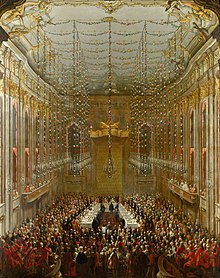You can help expand this article with text translated from the corresponding article in German. (February 2015) Click for important translation instructions.
|
| Martin van Meytens | |
|---|---|
 van Meytens, Self-Portrait, c. 1740s. van Meytens, Self-Portrait, c. 1740s. | |
| Born | 24 June 1695 Stockholm, Sweden |
| Died | 23 March 1770 (1770-03-24) (aged 74) Vienna, Austria |
Martin van Meytens (24 June 1695 – 23 March 1770) was a Swedish-Austrian painter who painted members of the Royal Court of Austria such as Marie Antoinette, Maria Theresa of Austria, Francis I, Holy Roman Emperor, the Emperor's family and members of the local aristocracy. His painting style inspired many other painters to paint in a similar format.
Life and career

Martin van Meytens was born and baptised in Stockholm, Sweden, son of the painter Martin Meytens the Elder, who had moved around 1677 from The Hague to Sweden. He went early in his career on an extended study trip. He visited London, Paris and Vienna, then he lived and worked for a long time in Italy (Rome, Turin). At the beginning he painted little enamel miniature portraits, and he changed to oil painting only around 1730, having settled in Vienna. Here he became very popular as a portrait painter in the circles of the court and the aristocracy. In 1732 he became a court painter, and in 1759 the director of the Viennese Academy of Fine Arts. Franz Xaver Messerschmidt was his protégé.
Meytens was one of the most significant Austrian painters of representative Baroque courtly portrait, and through his pupils and followers his influence remained alive and widespread for a long time throughout the whole Empire. His personal virtues, varied interests, erudition and pleasant manners were highly appreciated by his contemporaries.
The Wedding Supper depicts the wedding of Princess Isabella of Parma and Joseph II, Holy Roman Emperor, 5 October 1760, at Hofburg Palace's Redoutensaele (Redoute Hall). The moment depicted is when the dessert is served, in the middle of the table is a garden made by sugar crust.
Among his pupils was Giovanni Gabriele Cantone (born Vienna, 24 May 1710).
Works
- ca. 1731; Kneeling Nun, Recto, (Nationalmuseum – Stockholm)
- 1741; Kaiser Franz I
- 1744; Maria Theresia, (Ghent Town Hall)
- 1745–1750; Familie der Grafen Pálffy
- 1750; Archduke Maximilian, (The Winnipeg Art Gallery)
- 1752–1753; Fam. Grill, ( Museum Gothenburg)
- 1750–1755; Maria Theresia als Herrscherin, (Schönbrunn Palace)
- 1754; Ksl. Familie, (Schönbrunn Palace);
- 1759; Maria Theresia, (Academy of Fine Arts)
Selected works
- Works
-
 Archduchess Maria Amalia of Austria (later Maria Amalia, Duchess of Parma)
Archduchess Maria Amalia of Austria (later Maria Amalia, Duchess of Parma)
-
 Archduchess Maria Antonia of Austria, 1767 (later Marie Antoinette, Queen of France)
Archduchess Maria Antonia of Austria, 1767 (later Marie Antoinette, Queen of France)
-
 Archduchess Maria Johanna Gabriela of Austria
Archduchess Maria Johanna Gabriela of Austria
-
 Maria Josepha of Bavaria, Holy Roman Empress
Maria Josepha of Bavaria, Holy Roman Empress
-
 Portrait of Emperor Francis I (workshop)
Portrait of Emperor Francis I (workshop)
-
 Joseph de France and his Family
Joseph de France and his Family
-
 Sackska family painting
Sackska family painting
-
 Carl Gustaf Tessin, Ulla Sparre of Sundby and Brita Stina Sparre
Carl Gustaf Tessin, Ulla Sparre of Sundby and Brita Stina Sparre
References
- "wedding-supper". Retrieved 9 December 2015.
- Biografia degli artisti, Volume one, Venice, Francesco de Boni, 1840, page 657.
Other sources
- Biography – Austria Forum
- Biography – Web Gallery of Art
- Biography and more paintings – ArtExperts.
External links
![]() Media related to Martin van Meytens at Wikimedia Commons
Media related to Martin van Meytens at Wikimedia Commons
- 1695 births
- 1770 deaths
- 18th-century Austrian painters
- 18th-century Austrian male artists
- Austrian male painters
- 18th-century Swedish painters
- 18th-century Swedish male artists
- Swedish male painters
- Painters from Stockholm
- Austrian people of Dutch descent
- Austrian people of Flemish descent
- Swedish people of Dutch descent
- Swedish emigrants
- Immigrants to the Holy Roman Empire